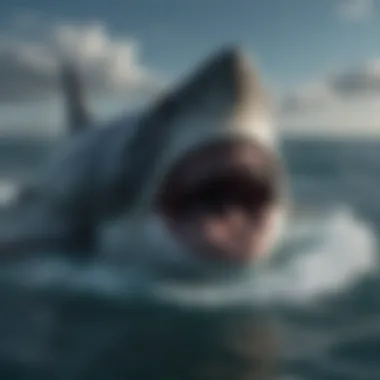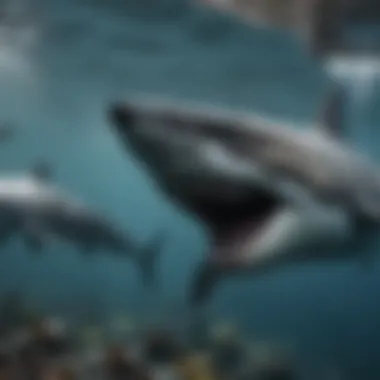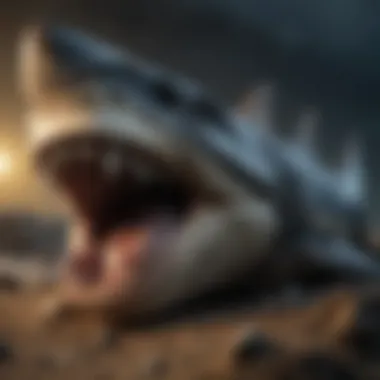Understanding Megalodon: The Ancient Predator of the Seas


Intro
Megalodon, one of the most extraordinary marine predators, swam the oceans millions of years ago. As a prehistoric shark, it reached exceptionally large sizes, dominating the seas. Through artifacts and fossil discoveries, we learn more about its anatomy, lifestyle, and habitat. This understanding provides insights into the ocean ecosystem then and helps to understand its eventual extinction. It also invites comparisons to modern sharks, revealing the evolutionary journey of these fascinating creatures.
This exploration expands beyond scientific facts. It includes cultural significance, how children can interact with this knowledge, and ways to raise awareness about marine conservation. Understanding Megalodon encourages appreciation for both marine biology and paleontology, while also teaching us about the importance of preserving our oceans today.
Nature Topic Overview
The Megalodon lived during the Cenozoic Era, specifically from about 23 million years ago until approximately 3.6 million years ago. This giant shark was likely one of the largest to have ever existed, reaching lengths of up to 60 feet. These massive creatures had a robust jaw, filled with large serrated teeth that were capable of crushing the bones of prey like whales. Understanding their role in ancient marine environments can illustrate the balance of ecosystems and the effects of top predators on their populations.
Different types of figures emerged within communities who rose to think about the existence of Megalodon. As researchers gathered more data through various fossil sites, awareness of the ancient marine lifeform transformed over the years.
Like other species, the Megalodon's adaptations were vital for its survival. Its size allowed for vast hunting grounds, aiding in the pursuit of large prey. Analyzing its habitat explains how geography, species interaction, and climate influenced its living conditions.
Fun Facts and Trivia
Megalodon remains an awe-inspiring subject of fascination for all ages. Here are some intriguing facts:
- It is believed that its teeth could be over 7 inches long.
- Some fossilized teeth have been found all around the world, indicating its widespread habitat.
- Megalodon was a part of a greater group known as
Prolusion to Megalodon
Megalodon, the giant shark that swam the oceans millions of years ago, fascinates many. To understand this incredible predator is important for several reasons. Firstly, it allows us to appreciate the depth of marine life that existed long before humans. Secondly, studying Megalodon helps scientists make connections between prehistoric and modern sharks. We can observe how environments and ecosystems change over time that can inform conservation efforts today. Understanding its historical significance can also spark a greater interest in marine biology among young learners.
Defining Megalodon
Megalodon refers to Carcharocles megalodon, which translates roughly to “big tooth.” This name was chosen because of its enormous fossilized teeth that have been found in various parts of the world. Megalodon lived approximately 23 to 3.6 million years ago during the Cenozoic Era. It is recognized particularly for its sheer size, with some estimates suggesting that it could reach lengths of up to 60 feet or more. Understanding what Megalodon was helps clear up misconceptions and create a base for further exploration of its life in ancient oceans.
Scientific Classification
In the realm of scientific classification, Megalodon resides within the animal kingdom of Animalia. Its strict placement can be framed as follows:
- Domain: Eukaryota
- Kingdom: Animalia
- Phylum: Chordata
- Class: Chondrichthyes
- Order: Lamniformes
- Family: Otodontidae
- Genus: Carcharocles
- Species: Carcharocles megalodon
This information enhances our grasp of how Megalodon fits into the larger ecological puzzle. Within the class Chondrichthyes, members have skeletons made of cartilage rather than bone, which is something that differentiates them from bony fish. Understandingably, this information supports both scholarly research and provides interesting learning about marine creatures.
“Megalodon was not just a shark; it was a symbol of apex predator from ancient times, reminding us about the role of giants in nature.”
Habitat and Distribution
Understanding the habitat and distribution of Megalodon provides crucial insight into its way of life and survival strategies. Analysing where it lived helps us comprehend its ecological role and determine how it adapted to different environments during its reign. Specific factors, such as water temperature, depth, and availability of prey, greatly influenced its distribution patterns across ancient oceans. By studying these elements, we gain a clearer picture of the ecosystem dynamics of the time and how Megalodon thrived within them.
Geographic Range
Megalodon occupied a vast area of the world's oceans. Its remains have been found on multiple continents, indicating a wide geographic range. The evidence suggests that it dwelt in warm, shallow coastal waters to deeper marine environments. Its fossils appear in locations like the United States, Europe, and parts of Africa and Australia. This extensive range permitted Megalodon to prey on various species and allowed for genetic diversity within populations.
Several geological studies reveal that Megalodon likely migrated between different terrains in search for food and optimal living conditions. The discovery of Megalodon teeth and partial fossils demonstrates some populations likely ventured extensively, adapting to several habitats throughout Earth's changing landscape. Understanding such movements is essential for reconstructing the ecological networks that prevailed during the epoch in which Megalodon thrived.
Preferred Environments
Megalodon preferred specific environments based on its hunting strategies and needs as a predatory shark. Warm, nutrient-rich waters formed its ideal habitat, fostering diverse marine life. Sharks, including Megalodon, often reside in areas where food sources are plentiful. Consequently, Megalodon pursued cooler, deeper zones and shallow coastlines teeming with prey.
Environment Qualities:


- Tropical and subtropical regions
- Annual sea surface temperatures averaging between 18-24°C
- Proximity to feeding grounds
Through stable temperature conditions and rich nutrition sources, it maximized chances for successful hunts. Finding these specifics demonstrates the strategic adaptability Megalodon utilized for thriving in various ocean environments. By studying its preferred surroundings, we enhance our comprehension of both its lifestyle and how various agents led to its eventual extinction.
By understanding the habitats and distribution of Megalodon, we better appreciate how life adapted to diverse environments.
Anatomy of Megalodon
The anatomy of Megalodon is vital to understanding how this great predator functioned in its environment. Its physical characteristics provided crucial advantages that supported its position at the top of the food chain. Being aware of Megalodon's anatomy offers insight into how it hunted, survived, and interacted with its ecosystems.
Size and Length
Megalodon is often recognized for its enormous size. Estimates suggest that it could grow up to 60 feet long or more, making it one of the largest sharks in history. This massive length compared to modern sharks signifies significant evolutionary traits. For instance, the Great White Shark, a modern relative, only reaches about 20 feet.
The sheer size of Megalodon was an essential factor in its hunting efficiency. A longer body allowed for more considerable muscle mass and greater swimming power. It developed strong jaws, filled with huge serrated teeth, crucial for catching large prey. It is fundamentally relevant to note how the size of this predator illustrates adaptability to its surroundings and available food sources.
Unique Features
Megalodon had several remarkable features that distinguished it from other sharks. Its jaw was extremely powerful, capable of exerting immense pressure. This force was crucial when biting into thick-skinned prey like whales. The teeth were not only large but also uniquely shaped, allowing the shark to grip and slice through flesh with ease.
Other unique features of Megalodon include:
- An astonishing number of teeth, often numbering over 250.
- A robust and streamlined body design, aiding in speed.
- A strong sense of smell, which was helpful for locating prey even in murky waters.
- Adaptability to different marine environments, indicating high levels of evolutionary flexibility.
Understanding these unique characteristics affords a clearer picture of how Megalodon thrived during its reign in prehistoric oceans.
Diet and Hunting Strategies
The diet and hunting strategies of Megalodon are critical components to understanding this ancient predator. Knowing what it ate and how it fed provides insight into its ecological role during its time. Megalodon was not just a shark; it was a dominant predator that influenced marine ecosystems. By examining its dietary preferences and hunting methods, we see how its lifestyle shaped the oceans it inhabited. This subject bridges biology and paleontology, giving young readers a sense of the vast timelines in Earth's history.
Prey Selection
Megalodon had a varied diet, which included large marine animals. Evidence suggests it primarily preyed on whales, large fish, and even other sharks. This significant selection of prey points to its adaptability and dominance as a predator.
Some organisms Megalodon might have hunted include:
- Whale species: The sheer power of Megalodon allowed it to hunt both small and large whale species, including those that dwarf modern whales.
- Other sharks: As an apex predator, Megalodon showed preference for its contemporary rivals.
- Large fish: Dining on schools of large fish offered Megalodon ample opportunities to hunt efficiently.
Megalodon's sharp teeth contributed greatly to its ferocious hunting abilities. These teeth were large, serrated, and strong, perfect for biting through tough skin and flesh. By selecting robust prey, it ensured that it had enough energy to support its large body size.
Hunting Techniques
The hunting strategies of Megalodon reflected its status as a top predator. Various techniques ensured the successful capture of its prey.
Megalodon's hunting techniques likely included:
- Ambush predator: Megalodon may have relied on stealth, waiting silently before launching a sudden and swift attack on its prey. Its size allowed it to reach incredible speeds in short bursts.
- Group coordination: Evidence supports the idea that some large predators hunted in groups. Collaborative hunting can increase success rates. These were likely coordinated efforts to capture large prey more effectively.
- Using environmental cues: Megalodon likely used currents, light reflections, or sounds to locate prey. Hunting in various water depths expanded its opportunities for hunting.
Ultimately, the success of Megalodon was its diverse hunting methods, enabling it to adapt to changes in the marine environment over the ages. Understanding how Megalodon fed highlights its function in the ecosystem, revealing the interplay between predator and prey in geological times.
Knowing about the Megalodon's diet helps in grasping its place within historical marine life, emphasizing important ecological connections that continue today.
Era of the Megalodon: Geological Timeline


The geological timeline is crucial for understanding the Megalodon, as it provides context for its existence, evolution, and eventual extinction. This section will explore key aspects such as the origins in the Miocene epoch and the various factors that contributed to the extinction of this ancient predator. By studying this timeline, we gain insight into the evolutionary history of Megalodon, as well as the ecological conditions of its time, enhancing our understanding of marine biology and paleontology.
Origins in the Miocene
Megalodon first emerged around 23 million years ago during the Miocene epoch. This period was marked by significant geological and climatic changes, which set the stage for the evolution of many marine species, including extinct sharks like Megalodon. The climate was generally warmer, allowing vast marine habitats to flourish. This is important because stable ocean temperatures promote biodiversity. Megalodon thrived in this diverse environment.
Some scientists believe that Megalodon evolved from Carcharocles anglen, a smaller shark. As the oceans changed and diversified, it allowed Megalodon to grow and dominate. Fossil evidence presents a varied diet largely consisting of large marine mammals, which became increasingly abundant during this period.
The Miocene's rich oceans facilitated the growth of large predators like Megalodon. This highlights not only the predator's capability, but also symbiotic relationships within marine ecosystems during that timeframe.
Extinction Factors
Megalodon existed for millions of years but ultimately faced extinction around 2.6 million years ago, at the end of the Pliocene epoch. Several factors contributed to this fading out of one of the sea's apex predators, and understanding them is important for recognizing ecological changes.
- Climate Change: The Earth's climate was gradually cooling, which drastically altered the ocean’s conditions.
- Prey Availability: As ocean environments transformed and species adapted, tugged at Megalodon’s primary food sources.
- Competition: New species of sharks emerged, leading to fierce predatory competition.
A particularly interesting aspect is how Megalodon had to adapt or possibly migrate that Georgia sea predators faced different environments along with newer evolutionary challenges. The changing dynamics of ecology proved deadly.
Understanding the causes of Megalodon's extinction helps us comprehend the fragility of marine ecosystems, informing modern conservation efforts.
In summary, the geological timeline highlights how Megalodon’s environment and the inherent challenges fell into place, ensuring its place in history as a remarkable prehistoric predator.
Fossil Evidence of Megalodon
Fossil evidence serves as a critical window into the life and environment of the ancient Megalodon. Understanding these findings provides insight into its anatomy, behavior, and ultimately, the reasons behind its extinction. The fossil remains, particularly teeth and bones, offer clues that allow scientists to piece together the biological puzzle of this mighty predator. This discussion captures the significance of these fossils in not just understanding Megalodon itself, but also the ecosystems it inhabited at that time.
Tooth Discoveries
Megalodon teeth are among the most plentiful fossil remains found, and their discovery holds significant importance. Each tooth serves as a record of not just size but also diet and hunting habits.
- Size: Megalodon teeth can measure over seven inches in length. This enormous size indicates the jaw's capacity, inferring the shark's capability to take down large prey.
- Shape: The distinctive triangular shape of the teeth hints at how Megalodon hunted and fed. Their sharp edges indicate they were designed for ripping through flesh.
- Stage of Growth: Researchers can determine the age and growth stages of Megalodon by studying tooth wear and replacement patterns. This information aids in understanding their life cycles.
In various locations, especially in the sediments over the continental shelf, tooth fossils have been found. Florida, for instance, is known for its rich collection of Megalodon teeth.
Comparative Analysis with Modern Sharks
The study of Megalodon offers significant insights into its similarities and differences with modern sharks. This analysis is crucial for understanding the evolutionary adaptations that have occurred over millions of years. New findings in shark biology aid in comprehending the ecological roles that these predators fill today. With modern sharks faced by numerous threats, understanding their ancestors might help in the conservation of their current relatives.
Similarities and Differences
Megalodon shares several features with contemporary sharks. For instance:
- Body Structure: Both Megalodon and sharks today possess a streamlined body, which aids in swift swimming.
- Teeth Structure: Megalodon's teeth are similar in shape to those of some great white sharks, favoring their feeding on large prey.
However, there are notable differences:
- Size: Megalodon reached lengths up to 60 feet, dwarfing the largest modern shark, the whale shark, which averages around 40 feet.
- Predatory Behavior: While Megalodon's size dictated its dominance, most modern sharks, like the tiger shark, utilize similar hunting techniques at much smaller scales.
Cultural Significance of Megalodon
Megalodon holds a significant place in both history and modern culture. This prehistoric creature fascinates many and encourages exploration into marine biology and conservation awareness. Understanding its importance helps illuminate our relationship with natural histories and inspires future generations to care about the oceans.
Representation in Media


Megalodon appears in various forms of media today, gracing movies, books, and television shows. Such representations have not only engaged general audiences but also sparked interest in education around marine life. Films like The Meg depict this shark as a colossal creature, blending facts with fiction. They often highlight megalodon’s extreme size and hunting prowess, creating an aura of fear and wonder.
Children enjoy these thrilling adventures, fueling curiosity about sharks and prehistoric life. Such media can serve as a starting point for discussions about real biology. Understanding the distinctions between fact and entertainment can encourage young minds to seek out knowledge.
- Movies: Films like The Meg and 47 Meters Down: Uncaged present a larger-than-life perspective on this ancient predator.
- Books: Numerous stories capture the imagination of readers, especially children, painting vivid pictures of what life might have been like in the ocean.
- Documentaries: Programs like those produced by National Geographic offer more factual insights while still being enthralling.
Through these varied mediums, Megalodon remains a powerful symbol of the mystery of the seas; its portrayal captures both fear and fascination.
Myths and Legends
Since its existence, Megalodon has woven itself into folklore and tales too. Many civilizations share sea narratives filled with enormous sea monsters, likely inspired by the remains and legends of this prehistoric shark. These stories serve various purposes, from cautionary tales to symbolic protectors of the waters.
One can see parallels in tales from different cultures:
- The Kraken: A giant sea monster known to sailors, consuming ships and other creatures of the sea. This creature reflects humanity's fear of the unknown depths, likely stemming from fearsome ancient survivors like Megalodon.
- Various Indigenous Cultures: Many sets of beliefs glorify sea creatures, equally emphasizing respect and caution when using marine resources. Just as Megalodon demanded respect clearly, this shows us how tradition shapes our understanding of marine life.
These myths influence how society perceives our oceans today, calculating its riches and dangers. The studies of these tales reveal much about human history and our respect for the ocean.
Ongoing Research and Discoveries
Ongoing research into Megalodon is crucial for understanding not only this ancient predator but also the broader context of marine evolution. Researchers are constantly discovering new fossil evidence and employing advanced techniques to analyze these findings. This gives scientists a clearer picture of Megalodon's life, behavior, and the ecosystems it inhabited. The continued study of Megalodon informs modern marine conservation efforts too. By learning about creatures that shaped the past, we can better understand the challenges that marine life faces today.
New Findings
Recent discoveries in paleontological sites have yielded remarkable new findings related to Megalodon. For instance, scientists have found well-preserved teeth and partial vertebrae that suggest new details about its size and feeding habits. Some studies mentioned that Megalodon's teeth are the largest of any shark species ever recorded, reaching over seven inches in length. Moreover, these findings reveal clues about their prey and hunting habits. More advanced imaging technology, such as 3D scanning, allows researchers to create models of fossils. This helps to reconstruct the ancient shark's physical characteristics.
• Teeth Analysis: New studies show that the serrations on Megalodon teeth are adapted for cutting through large animals effectively.
• Stable Isotope Analysis: This method helps understand the diet and tendencies, revealing insights on its prey from isotopic composition.
These discoveries contribute significantly to our knowledge. The information shapes our understanding of how Megalodon lived and can retroactively inform how ancient ecosystems functioned.
“New discoveries tell us more than just facts. They broaden our understanding of how life changed in our oceans over millions of years.”
Future Research Directions
The future of research concerning Megalodon promises to be just as interesting as its past. Scientists are putting forth various methodologies and questions that could uncover more about this shark's life. For example, one area of focus is the genetic studies of modern sharks. It could highlight connections between them and their ancient counterparts, possibly offering insights on how traits evolved. This merges genetics with paleontology, expanding the scope of both fields. Future studies may investigate:
- Tagging and Tracking: Understanding how current shark species behave could lead to better interpretations of Megalodon's habits.
- Climate Impact Studies: Researchers anticipate exploration of how shifts in climate during Megalodon's time may have affected oceanic fauna and flora.
- Technological Advancements: Beyond imaging technologies, new analytical tools may soon emerge that further refine our understanding.
While many aspects of Megalodon remain a mystery, dedicated research continues to unfold new realms of discovery. With each significant finding, the legacy of this prehistoric creature comes more alive to current generations.
Ending: The Legacy of Megalodon
The legacy of Megalodon is significant in understanding the historical narrative of marine ecosystems. This massive shark etched its presence in the ocean, influencing the balancing act of the food chain and cementing its role as a top predator. Examining Megalodon deepens our knowledge about realities of prehistoric times and the interactions between different species.
Impact on Marine Ecosystems
Megalodon’s widespread reign occurred during the Cenozoic era, which included a variety of shark species aside from itself. Its legacy reflects major points concerning marine ecosystems:
- Impact on Prey Species: As a dominant predator, Megalodon played a crucial role in regulating population dynamics. The hunting of other marine animals ensured a balanced ecosystem.
- Competition and Adaptation: It influenced other predators as well. Megalodon’s success forced other marine animals to adapt or risk extinction. Such adaptations can be observed in the evolutionary history of species that followed.
- Biodiversity Influence: The presence and absence of Megalodon shaped marine biodiversity even after its extinction. Studies indicate that predator-prey relationships continue to dictate life in oceans today.
Understanding the past can shape our approach to present-day conservation efforts.
Lessons for Modern Conservation
Megalodon’s remarkable size and predatory nature can provide insight into contemporary conservation strategies. Its extinction underscores critical awareness for the health of marine environments:
- Ecological Balance: Maintaining predator species is vital for marine health. Overfishing threatens balance, showcasing the importance of sustainable practices.
- Habitat Preservation: Just as marine landscapes changed when Megalodon vanished, modern science shows how disrupting ecosystems affects biodiversity. Protecting habitats is paramount.
- Visiting Historical Threats: Revelations about ancient species show how previous mass extinction events relate to today's threats, leading to urgency in conservation measures.







